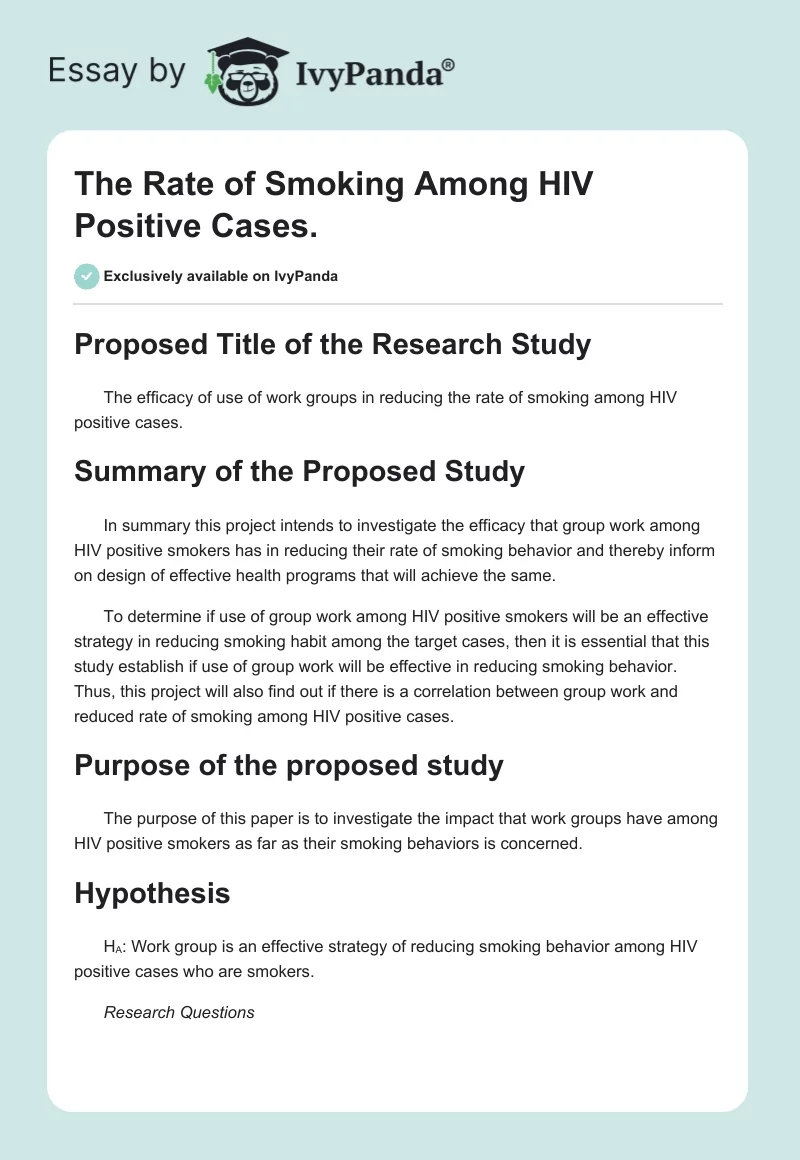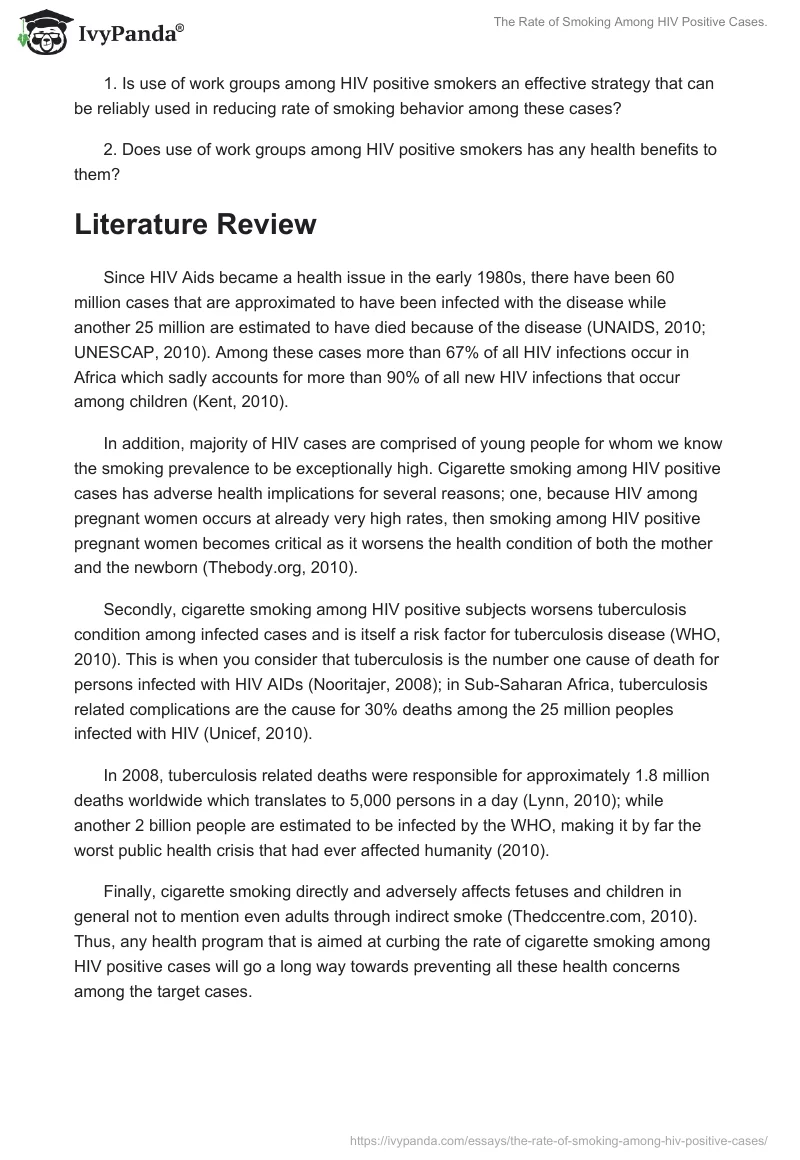Proposed Title of the Research Study
The efficacy of use of work groups in reducing the rate of smoking among HIV positive cases.
Summary of the Proposed Study
In summary this project intends to investigate the efficacy that group work among HIV positive smokers has in reducing their rate of smoking behavior and thereby inform on design of effective health programs that will achieve the same.
To determine if use of group work among HIV positive smokers will be an effective strategy in reducing smoking habit among the target cases, then it is essential that this study establish if use of group work will be effective in reducing smoking behavior. Thus, this project will also find out if there is a correlation between group work and reduced rate of smoking among HIV positive cases.
Purpose of the proposed study
The purpose of this paper is to investigate the impact that work groups have among HIV positive smokers as far as their smoking behaviors is concerned.
Hypothesis
HA: Work group is an effective strategy of reducing smoking behavior among HIV positive cases who are smokers.
Research Questions
- Is use of work groups among HIV positive smokers an effective strategy that can be reliably used in reducing rate of smoking behavior among these cases?
- Does use of work groups among HIV positive smokers has any health benefits to them?
Literature Review
Since HIV Aids became a health issue in the early 1980s, there have been 60 million cases that are approximated to have been infected with the disease while another 25 million are estimated to have died because of the disease (UNAIDS, 2010; UNESCAP, 2010). Among these cases more than 67% of all HIV infections occur in Africa which sadly accounts for more than 90% of all new HIV infections that occur among children (Kent, 2010).
In addition, majority of HIV cases are comprised of young people for whom we know the smoking prevalence to be exceptionally high. Cigarette smoking among HIV positive cases has adverse health implications for several reasons; one, because HIV among pregnant women occurs at already very high rates, then smoking among HIV positive pregnant women becomes critical as it worsens the health condition of both the mother and the newborn (Thebody.org, 2010).
Secondly, cigarette smoking among HIV positive subjects worsens tuberculosis condition among infected cases and is itself a risk factor for tuberculosis disease (WHO, 2010). This is when you consider that tuberculosis is the number one cause of death for persons infected with HIV AIDs (Nooritajer, 2008); in Sub-Saharan Africa, tuberculosis related complications are the cause for 30% deaths among the 25 million peoples infected with HIV (Unicef, 2010).
In 2008, tuberculosis related deaths were responsible for approximately 1.8 million deaths worldwide which translates to 5,000 persons in a day (Lynn, 2010); while another 2 billion people are estimated to be infected by the WHO, making it by far the worst public health crisis that had ever affected humanity (2010).
Finally, cigarette smoking directly and adversely affects fetuses and children in general not to mention even adults through indirect smoke (Thedccentre.com, 2010). Thus, any health program that is aimed at curbing the rate of cigarette smoking among HIV positive cases will go a long way towards preventing all these health concerns among the target cases.
Research Methodology
The research design for this research will be a cohort study that utilizes use of questionnaire as well as desk-based review of relevant literature. Desk based research will analyze the existing literature on the same topic of HIV cases and the efficacy of group work in reducing smoking habit.
Depending on the group sizes survey research design can also be used; survey research designs involve data collection from a specified sample size in order to arrive at an accurate assessment of the whole population regarding specific variables that the study intends to find out (Babbie, 1992; Newman, 1994).
As such survey research study is most suitable in studies that involve investigation of opinions, behaviors, attitudes, perceptions, culture orientation and so on which is similar to what we shall be investigating in this case (Adams and Schvaneveldt, 1985; Shuttleworth, 2010). That is the impact that work groups have in influencing HIV positive cases from heightened level of smoking.
Survey research study is especially suited to this type of study since it is possible to customize the research study to focus on key areas of interest (Kovacs, 1985; Leedy, 1993). Additionally, questionnaires will be used to collect data on key variables of the research study which would be targeted at the two groups of individuals; the HIV positive smokers participating in work groups (cases) and HIV positive smokers not participating in work groups whom in this case will be the control group.
For this reason, this research will be designed in a form of cohort study where cases from both categories will be followed up over time to determine if the HIV positive smokers participating in work groups do indeed have reduced spans of smoking compared to those who don’t participate in work groups.
Significance of the research
This research study is relevant in that it will lead to formulation of effective strategies that will enable caregivers design programs for HIV positive cases that are meant to empower them reduce their smoking habits. More importantly, the findings of this research study will go a long way towards improving the overall health of HIV positive smokers and thereby reduce the chances of health complications among these cases.
Generally, the implications of research findings that will be obtained from this study are many and include strengthening of health programs aimed at HIV positive smokers as well as generation of crucial information that will increase the available literature review in this field of study.
Ethical considerations
This research study will conform with relevant laws that governs all form of research studies at both local and international levels. Permits and licenses will be applied and relevant authorities informed beforehand so as to obtain their consent well on time.
Because this research study will involve use of questionnaires among human subjects I intend to guarantee the privacy of respondent and their feedback in accordance with the international standards of research studies.
Anticipated problems and limitations
Like all other research studies, this too will be limited by issues of time and costs; because time and cost factors impacts on the final results of a study, this research study will be limited in both its breadth and depth and generalization of the findings might not be applicable in a wide scale.
Finally, there is possibility of other factors that could negatively or positively impact on smoking habits among study subjects which are likely to interfere with my research questions as they will compound the variables that I will be investigating.
References
Adams, G. & Schvaneveldt, K. (1985). Understanding Research Methods. New York, NY; Longman Inc.
Babbie, E. (1992). The Practice of Social Research. California, CA; Wadswork Publishing Company.
Kovacs, A. (1985). The Research Process: Essential of Skill Development. Philadelphia. Davis Company.
Kent, J. (2010). Statistics: HIV AIDS, malaria and tuberculosis. Web.
Lynn, J. (2010). Malaria AIDS, TB in Retreat-Global Fund. Web.
Leedy, P. (1993). Practical Research: Planning and Design. New York, NY; Macmillan Publishing Company.
Nooritajer M. (2008). Review of tuberculosis. Middle East Journal of Nursing, 2(2): 542-563.
Newman, L. (1994). Social Research Methods. Boston; Allys & Bacons.
Shuttleworth, M. (2010). Pretest-Posttest Research Designs. Web.
Thedccentre. (2010). Smoking and HIV Aids. Web.
Thebody. (2010). Cigarette Smoking and HIV Aids. Web.
Unicef. (2010). The Africa malaria and TB report. Web.
UNESCAP. (2010). Combat HIV/AIDS, malaria and other diseases. Web.
UNAIDS. (2010). Middle East and North Africa: AIDS epidemic update Regional Summary. Web.
WHO. (2010). Tuberculosis. Web.


